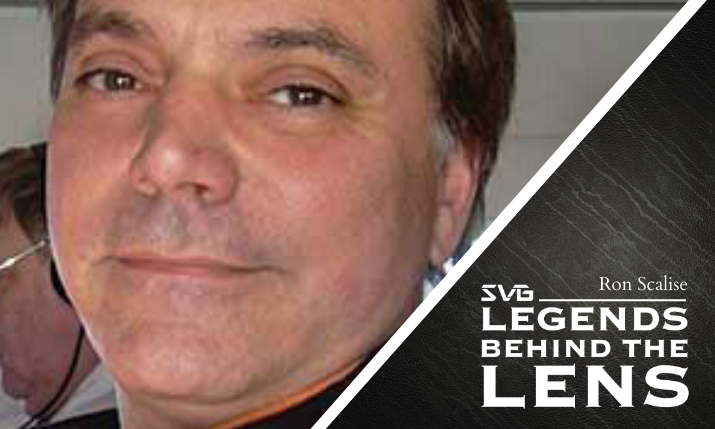Legends Behind the Lens: Ron Scalise
The audio maven was one of the industry's most passionate, hardest working individuals
Story Highlights

The story of American sports television is engrained in the history of this nation, rising on the achievements of countless incredible men and women who never once appeared on our screens. During this pause in live sports, SVG is proud to present a celebration of this great industry. Legends Behind the Lens is a look at how we got here seen through the people who willed it to be. Each weekday, we will share with you the story of a person whose impact on the sports-television industry is indelible.
Legends Behind the Lens is presented in association with the Sports Broadcasting Hall of Fame and the SVG Sports Broadcasting Fund. In these trying times — with so many video-production professionals out of work — we hope that you will consider (if you are able) donating to the Sports Broadcasting Fund. Do so by visiting sportsbroadcastfund.org.
___________________________
By Ken Kerschbaumer
It was in the early 1980s when Ron Scalise joined ESPN as an A2, helping the then-fledgling network cover events at the Hartford (CT) Civic Center.
Over the next 25 years, his impact on the industry followed the same trajectory as that of the network, and Scalise not only redefined the sports-audio experience for viewers of ESPN but to have an influence that extended to those of other networks through passion, dedication, and education.
“Ron was more than just an audio guy; he was an audio evangelist,” says Tom Sahara, VP of operations and technology, Turner Sports. “He understood that sending out six channels of audio is not enough. Audio is more than just sound; it is the experience. And Ron tried to instill this philosophy in everyone who worked with him.”
Until his death in 2007 at the age of 54, Scalise, day in and day out, was committed to bringing fans closer to the action through audio. The X Games were a favorite, giving him a wide canvas to experiment with audio and new microphone techniques. And his consistent pushing on events like NASCAR races or Monday Night Football brought ESPN viewers closer to the action.
“I’m not there to make a National Geographic special: it has to sound bigger than life,” he said. “When a zoom lens focuses in on a quarterback’s eyes, I want to let viewers hear the QB call and the crunching and grinding.”
Making the Audio More Effective
Jeff Willis, coordinating technical manager, ESPN Event Operations, recalls that Scalise was always tinkering and looking for ways to enhance the audio experience. Whether taking parts of headsets from different manufacturers to better suit his needs or building from scratch a custom microphone bracket to be worn by NFL officials, he was always innovating.
“Ron was more than just an audio guy; he was an audio evangelist. He understood that sending out six channels of audio is not enough. Audio is more than just sound; it is the experience. And Ron tried to instill this philosophy in everyone who worked with him.” – former Turner Sports executive Tom Sahara
His R&D work on the X Games was groundbreaking, spearheading many innovations with audio trunking, mic placement, and the transition to digital audio. In the late ’90s, he worked with a specialty-audio vendor to test and develop an effects mic known as the “X-Ducer,” a small device that he began placing under the ice, under the basketball floor, and on every piece of apparatus within the X Games domain. Even figure-skating coverage benefited from his desire to always do better.
“We did a skating program in 2006, and he said, why don’t we put some X-Ducers in the ice?” says Willis. Willis recommended putting the X-Ducers about a foot from the sideboards, but, when he showed up for the show, Scalise had pushed them out to 4 or 5 ft. instead, working with the crew who laid the ice to ensure that the mics were properly in place.
“They produced a sound I had never heard before on any skating show, and some of the skaters previewed and didn’t like it because, if they came down wrong, you would actually be able to hear if the landing wasn’t clean and crisp,” Willis adds.
Natural but Better
Among Scalise’s favorite events were NASCAR races, and he would push the limits of the natural sound of the race right up below the announcers, heightening the drama because the announcers needed to work at talking over the race audio. And then there are the smaller things, like hearing an air gun on a pit stop or the squeal of tires as cars zipped out of the pit road.
After beginning at the Hartford Civic Center for ESPN, Scalise slowly worked his way into the mainstream doing college football, basketball, and every important event, including NFL games. It was during Sunday Night Football telecasts that he began to lay the foundation for today’s ESPN’s surround sound philosophy.
“We tested surround sound for two or three years on Sunday Night Football before it was even delivered to viewers,” says Willis, adding, “Ron was a mentor to me.”
And to many more.
